2014 NISSAN CUBE child restraint
[x] Cancel search: child restraintPage 11 of 332
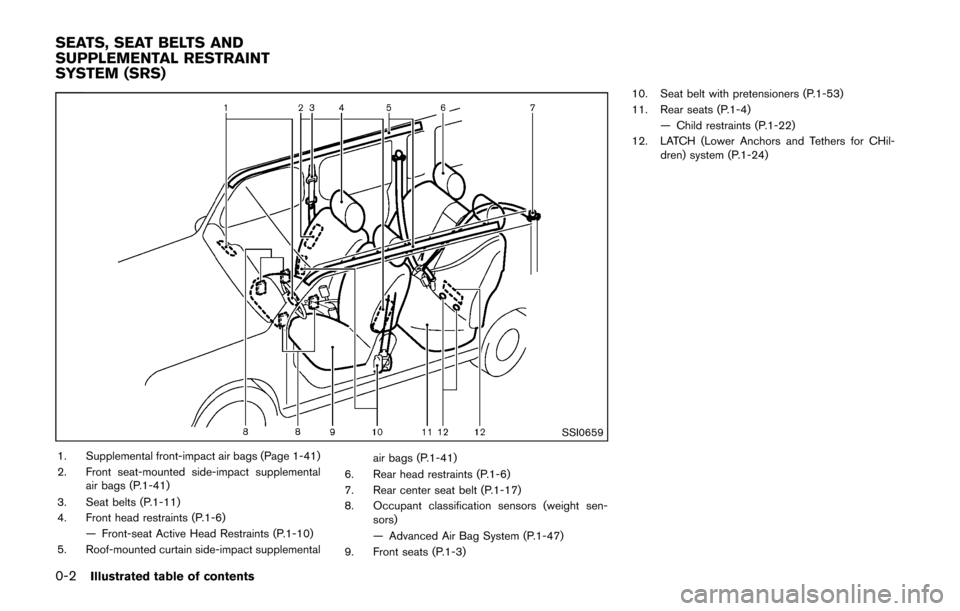
0-2Illustrated table of contents
SSI0659
1. Supplemental front-impact air bags (Page 1-41)
2. Front seat-mounted side-impact supplementalair bags (P.1-41)
3. Seat belts (P.1-11)
4. Front head restraints (P.1-6) — Front-seat Active Head Restraints (P.1-10)
5. Roof-mounted curtain side-impact supplemental air bags (P.1-41)
6. Rear head restraints (P.1-6)
7. Rear center seat belt (P.1-17)
8. Occupant classification sensors (weight sen- sors)
— Advanced Air Bag System (P.1-47)
9. Front seats (P.1-3) 10. Seat belt with pretensioners (P.1-53)
11. Rear seats (P.1-4)
— Child restraints (P.1-22)
12. LATCH (Lower Anchors and Tethers for CHil- dren) system (P.1-24)
SEATS, SEAT BELTS AND
SUPPLEMENTAL RESTRAINT
SYSTEM (SRS)
Page 20 of 332
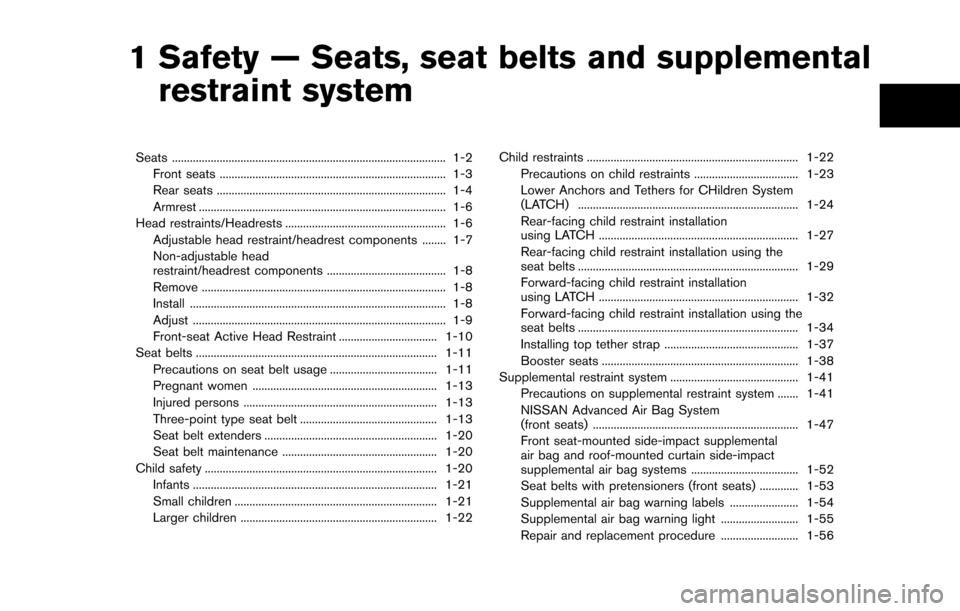
1 Safety — Seats, seat belts and supplementalrestraint system
Seats ........................................................................\
.................... 1-2
Front seats ........................................................................\
.... 1-3
Rear seats ........................................................................\
..... 1-4
Armrest ........................................................................\
........... 1-6
Head restraints/Headrests ...................................................... 1-6 Adjustable head restraint/headrest components ........ 1-7
Non-adjustable head
restraint/headrest components ........................................ 1-8
Remove ........................................................................\
.......... 1-8
Install ........................................................................\
.............. 1-8
Adjust ........................................................................\
............. 1-9
Front-seat Active Head Restraint ................................. 1-10
Seat belts ........................................................................\
......... 1-11
Precautions on seat belt usage .................................... 1-11
Pregnant women .............................................................. 1-13
Injured persons ................................................................. 1-13
Three-point type seat belt .............................................. 1-13
Seat belt extenders .......................................................... 1-20
Seat belt maintenance .................................................... 1-20
Child safety ........................................................................\
...... 1-20 Infants ........................................................................\
.......... 1-21
Small children .................................................................... 1-21
Larger children .................................................................. 1-22 Child restraints ....................................................................... 1-22
Precautions on child restraints ................................... 1-23
Lower Anchors and Tethers for CHildren System
(LATCH) ........................................................................\
.. 1-24
Rear-facing child restraint installation
using LATCH ................................................................... 1-27
Rear-facing child restraint installation using the
seat belts ........................................................................\
.. 1-29
Forward-facing child restraint installation
using LATCH ................................................................... 1-32
Forward-facing child restraint installation using the
seat belts ........................................................................\
.. 1-34
Installing top tether strap ............................................. 1-37
Booster seats .................................................................. 1-38
Supplemental restraint system ........................................... 1-41 Precautions on supplemental restraint system ....... 1-41
NISSAN Advanced Air Bag System
(front seats) ..................................................................... 1-47
Front seat-mounted side-impact supplemental
air bag and roof-mounted curtain side-impact
supplemental air bag systems .................................... 1-52
Seat belts with pretensioners (front seats) ............. 1-53
Supplemental air bag warning labels ....................... 1-54
Supplemental air bag warning light .......................... 1-55
Repair and replacement procedure .......................... 1-56
Page 21 of 332
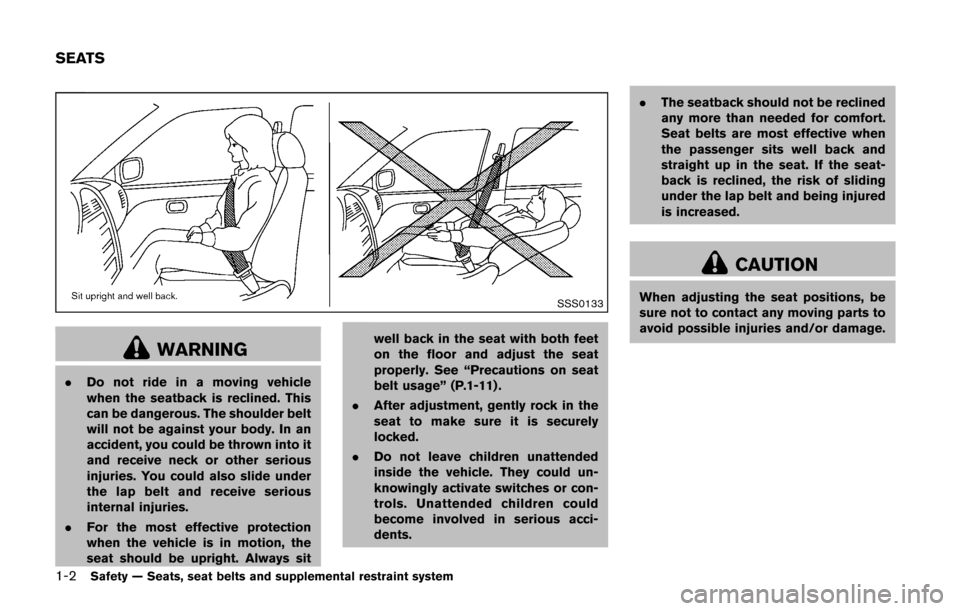
1-2Safety — Seats, seat belts and supplemental restraint system
SSS0133
WARNING
.Do not ride in a moving vehicle
when the seatback is reclined. This
can be dangerous. The shoulder belt
will not be against your body. In an
accident, you could be thrown into it
and receive neck or other serious
injuries. You could also slide under
the lap belt and receive serious
internal injuries.
. For the most effective protection
when the vehicle is in motion, the
seat should be upright. Always sit well back in the seat with both feet
on the floor and adjust the seat
properly. See “Precautions on seat
belt usage” (P.1-11) .
. After adjustment, gently rock in the
seat to make sure it is securely
locked.
. Do not leave children unattended
inside the vehicle. They could un-
knowingly activate switches or con-
trols. Unattended children could
become involved in serious acci-
dents. .
The seatback should not be reclined
any more than needed for comfort.
Seat belts are most effective when
the passenger sits well back and
straight up in the seat. If the seat-
back is reclined, the risk of sliding
under the lap belt and being injured
is increased.
CAUTION
When adjusting the seat positions, be
sure not to contact any moving parts to
avoid possible injuries and/or damage.
SEATS
Page 31 of 332
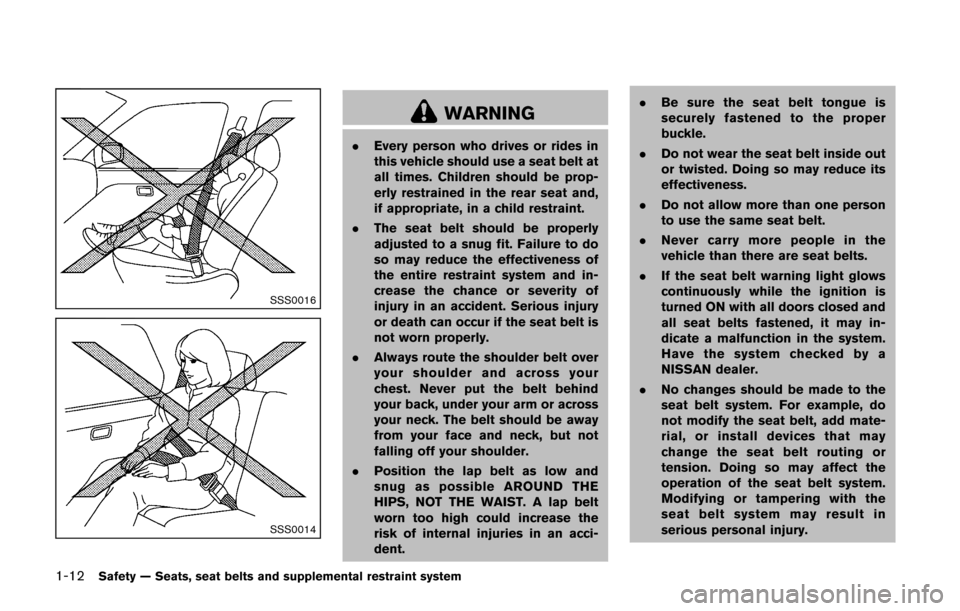
1-12Safety — Seats, seat belts and supplemental restraint system
SSS0016
SSS0014
WARNING
.Every person who drives or rides in
this vehicle should use a seat belt at
all times. Children should be prop-
erly restrained in the rear seat and,
if appropriate, in a child restraint.
. The seat belt should be properly
adjusted to a snug fit. Failure to do
so may reduce the effectiveness of
the entire restraint system and in-
crease the chance or severity of
injury in an accident. Serious injury
or death can occur if the seat belt is
not worn properly.
. Always route the shoulder belt over
your shoulder and across your
chest. Never put the belt behind
your back, under your arm or across
your neck. The belt should be away
from your face and neck, but not
falling off your shoulder.
. Position the lap belt as low and
snug as possible AROUND THE
HIPS, NOT THE WAIST. A lap belt
worn too high could increase the
risk of internal injuries in an acci-
dent. .
Be sure the seat belt tongue is
securely fastened to the proper
buckle.
. Do not wear the seat belt inside out
or twisted. Doing so may reduce its
effectiveness.
. Do not allow more than one person
to use the same seat belt.
. Never carry more people in the
vehicle than there are seat belts.
. If the seat belt warning light glows
continuously while the ignition is
turned ON with all doors closed and
all seat belts fastened, it may in-
dicate a malfunction in the system.
Have the system checked by a
NISSAN dealer.
. No changes should be made to the
seat belt system. For example, do
not modify the seat belt, add mate-
rial, or install devices that may
change the seat belt routing or
tension. Doing so may affect the
operation of the seat belt system.
Modifying or tampering with the
seat belt system may result in
serious personal injury.
Page 32 of 332
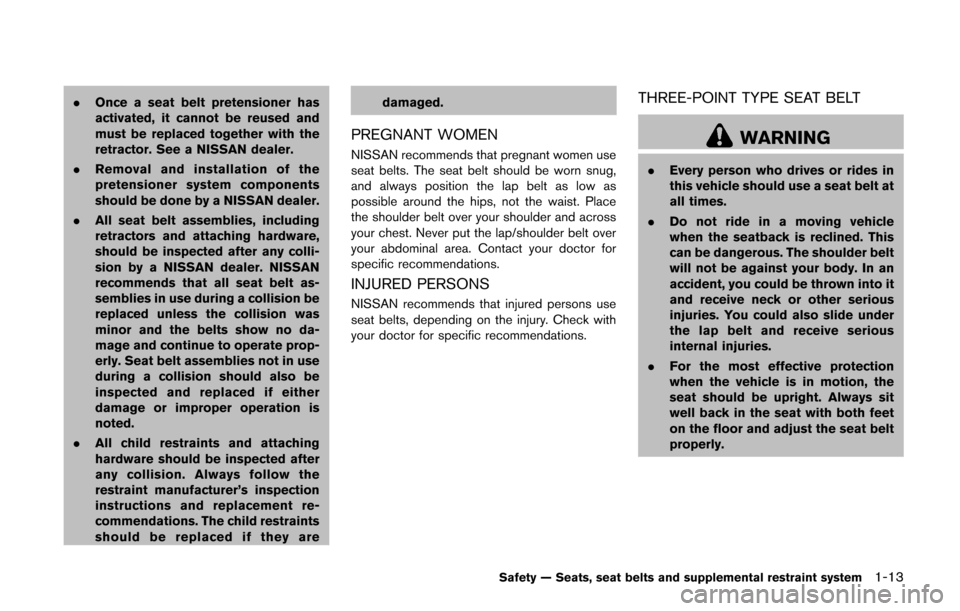
.Once a seat belt pretensioner has
activated, it cannot be reused and
must be replaced together with the
retractor. See a NISSAN dealer.
. Removal and installation of the
pretensioner system components
should be done by a NISSAN dealer.
. All seat belt assemblies, including
retractors and attaching hardware,
should be inspected after any colli-
sion by a NISSAN dealer. NISSAN
recommends that all seat belt as-
semblies in use during a collision be
replaced unless the collision was
minor and the belts show no da-
mage and continue to operate prop-
erly. Seat belt assemblies not in use
during a collision should also be
inspected and replaced if either
damage or improper operation is
noted.
. All child restraints and attaching
hardware should be inspected after
any collision. Always follow the
restraint manufacturer’s inspection
instructions and replacement re-
commendations. The child restraints
should be replaced if they are damaged.
PREGNANT WOMEN
NISSAN recommends that pregnant women use
seat belts. The seat belt should be worn snug,
and always position the lap belt as low as
possible around the hips, not the waist. Place
the shoulder belt over your shoulder and across
your chest. Never put the lap/shoulder belt over
your abdominal area. Contact your doctor for
specific recommendations.
INJURED PERSONS
NISSAN recommends that injured persons use
seat belts, depending on the injury. Check with
your doctor for specific recommendations.
THREE-POINT TYPE SEAT BELT
WARNING
.
Every person who drives or rides in
this vehicle should use a seat belt at
all times.
. Do not ride in a moving vehicle
when the seatback is reclined. This
can be dangerous. The shoulder belt
will not be against your body. In an
accident, you could be thrown into it
and receive neck or other serious
injuries. You could also slide under
the lap belt and receive serious
internal injuries.
. For the most effective protection
when the vehicle is in motion, the
seat should be upright. Always sit
well back in the seat with both feet
on the floor and adjust the seat belt
properly.
Safety — Seats, seat belts and supplemental restraint system1-13
Page 33 of 332
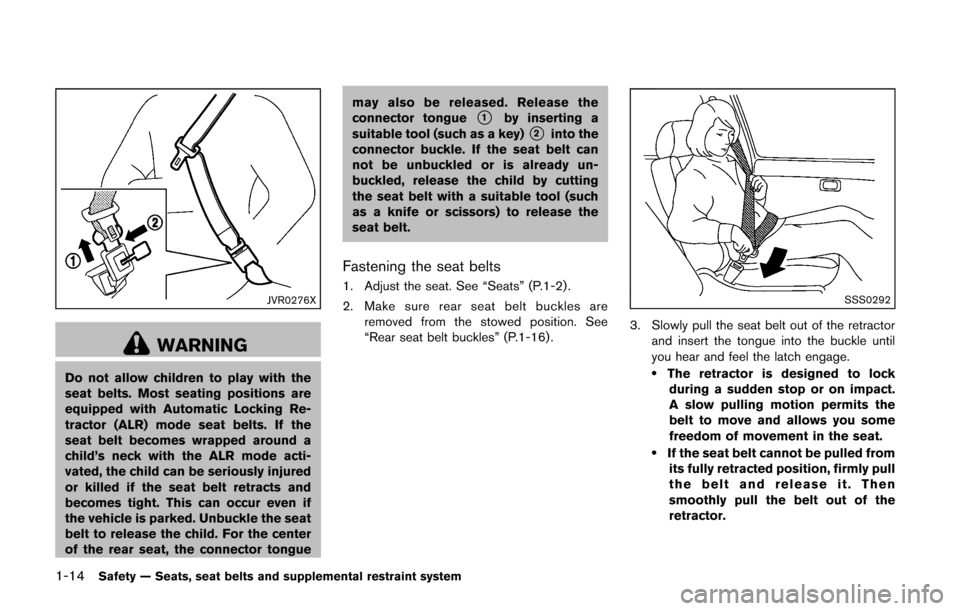
1-14Safety — Seats, seat belts and supplemental restraint system
JVR0276X
WARNING
Do not allow children to play with the
seat belts. Most seating positions are
equipped with Automatic Locking Re-
tractor (ALR) mode seat belts. If the
seat belt becomes wrapped around a
child’s neck with the ALR mode acti-
vated, the child can be seriously injured
or killed if the seat belt retracts and
becomes tight. This can occur even if
the vehicle is parked. Unbuckle the seat
belt to release the child. For the center
of the rear seat, the connector tonguemay also be released. Release the
connector tongue
*1by inserting a
suitable tool (such as a key)*2into the
connector buckle. If the seat belt can
not be unbuckled or is already un-
buckled, release the child by cutting
the seat belt with a suitable tool (such
as a knife or scissors) to release the
seat belt.
Fastening the seat belts
1. Adjust the seat. See “Seats” (P.1-2) .
2. Make sure rear seat belt buckles are
removed from the stowed position. See
“Rear seat belt buckles” (P.1-16) .SSS0292
3. Slowly pull the seat belt out of the retractorand insert the tongue into the buckle until
you hear and feel the latch engage.
.The retractor is designed to lockduring a sudden stop or on impact.
A slow pulling motion permits the
belt to move and allows you some
freedom of movement in the seat.
.If the seat belt cannot be pulled from its fully retracted position, firmly pull
the belt and release it. Then
smoothly pull the belt out of the
retractor.
Page 34 of 332
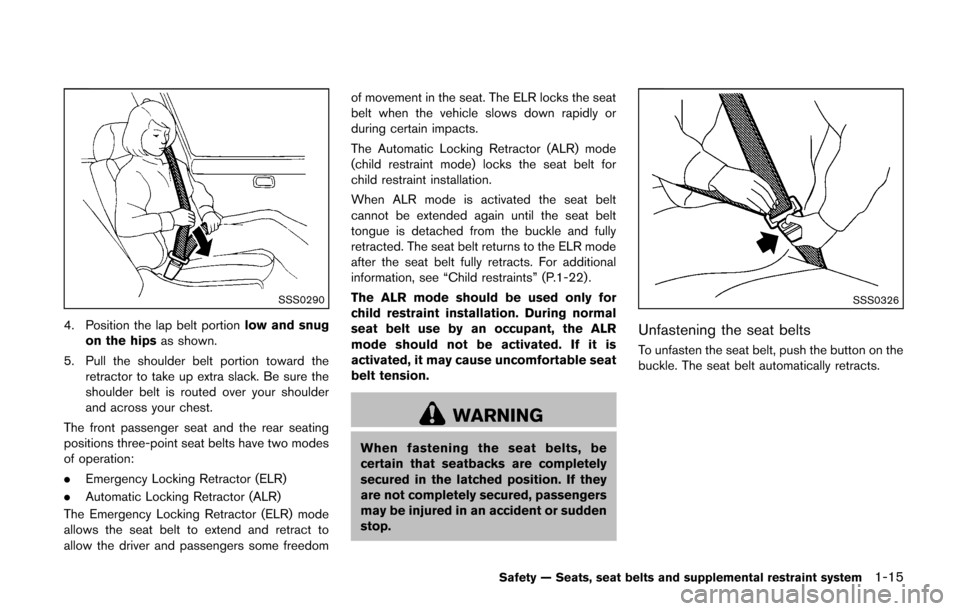
SSS0290
4. Position the lap belt portionlow and snug
on the hips as shown.
5. Pull the shoulder belt portion toward the retractor to take up extra slack. Be sure the
shoulder belt is routed over your shoulder
and across your chest.
The front passenger seat and the rear seating
positions three-point seat belts have two modes
of operation:
. Emergency Locking Retractor (ELR)
. Automatic Locking Retractor (ALR)
The Emergency Locking Retractor (ELR) mode
allows the seat belt to extend and retract to
allow the driver and passengers some freedom of movement in the seat. The ELR locks the seat
belt when the vehicle slows down rapidly or
during certain impacts.
The Automatic Locking Retractor (ALR) mode
(child restraint mode) locks the seat belt for
child restraint installation.
When ALR mode is activated the seat belt
cannot be extended again until the seat belt
tongue is detached from the buckle and fully
retracted. The seat belt returns to the ELR mode
after the seat belt fully retracts. For additional
information, see “Child restraints” (P.1-22) .
The ALR mode should be used only for
child restraint installation. During normal
seat belt use by an occupant, the ALR
mode should not be activated. If it is
activated, it may cause uncomfortable seat
belt tension.
WARNING
When fastening the seat belts, be
certain that seatbacks are completely
secured in the latched position. If they
are not completely secured, passengers
may be injured in an accident or sudden
stop.
SSS0326
Unfastening the seat belts
To unfasten the seat belt, push the button on the
buckle. The seat belt automatically retracts.
Safety — Seats, seat belts and supplemental restraint system1-15
Page 37 of 332
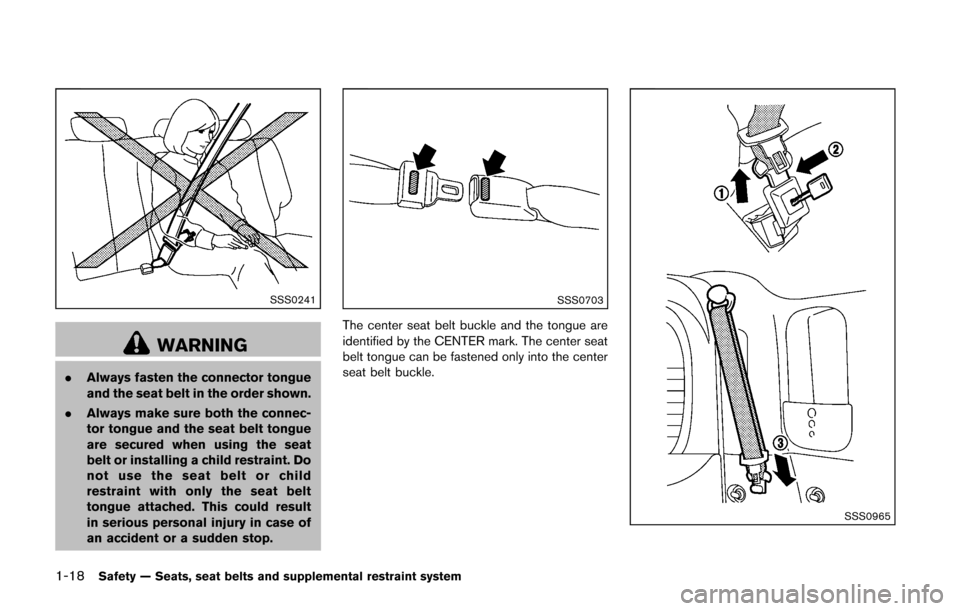
1-18Safety — Seats, seat belts and supplemental restraint system
SSS0241
WARNING
.Always fasten the connector tongue
and the seat belt in the order shown.
. Always make sure both the connec-
tor tongue and the seat belt tongue
are secured when using the seat
belt or installing a child restraint. Do
not use the seat belt or child
restraint with only the seat belt
tongue attached. This could result
in serious personal injury in case of
an accident or a sudden stop.
SSS0703
The center seat belt buckle and the tongue are
identified by the CENTER mark. The center seat
belt tongue can be fastened only into the center
seat belt buckle.
SSS0965